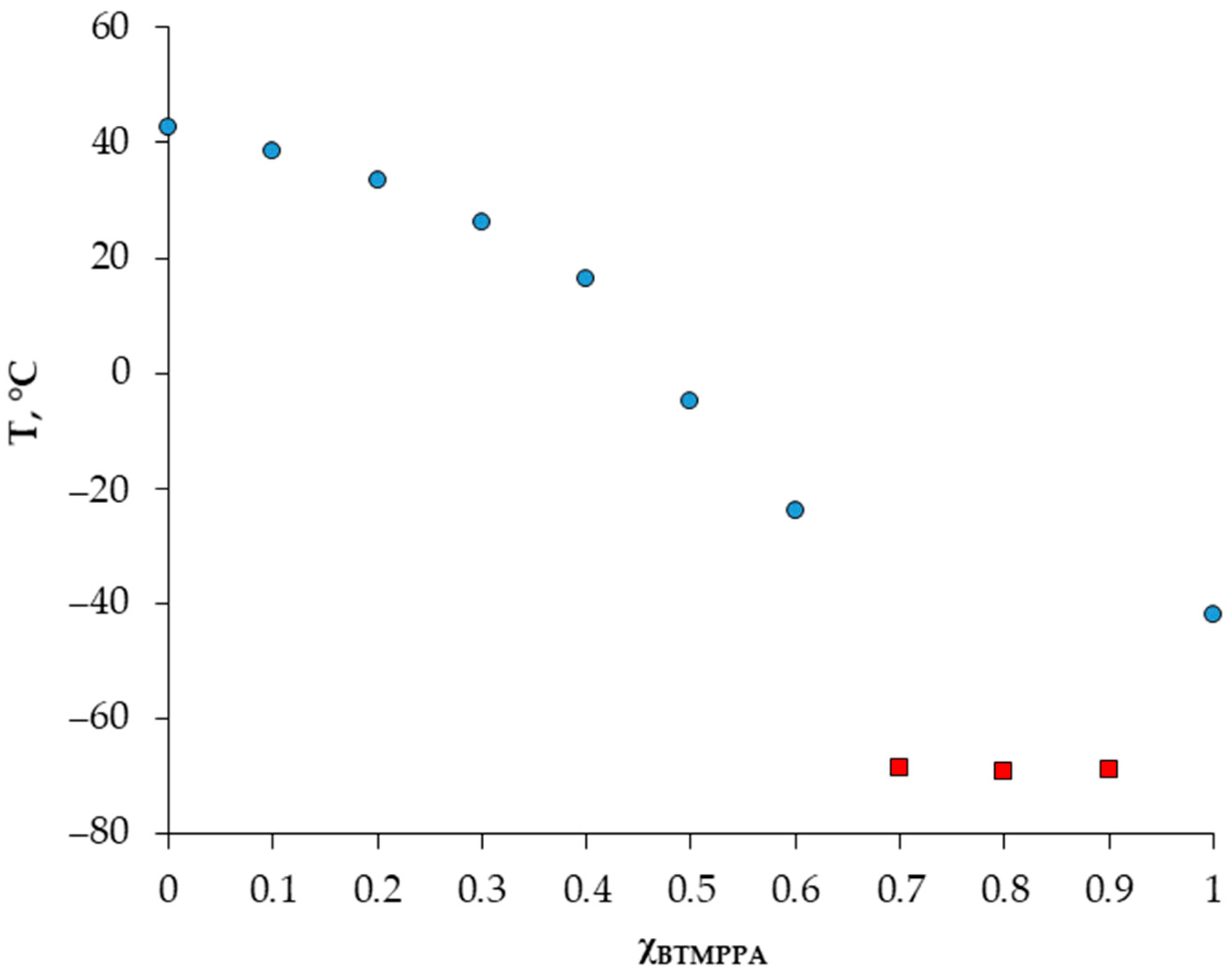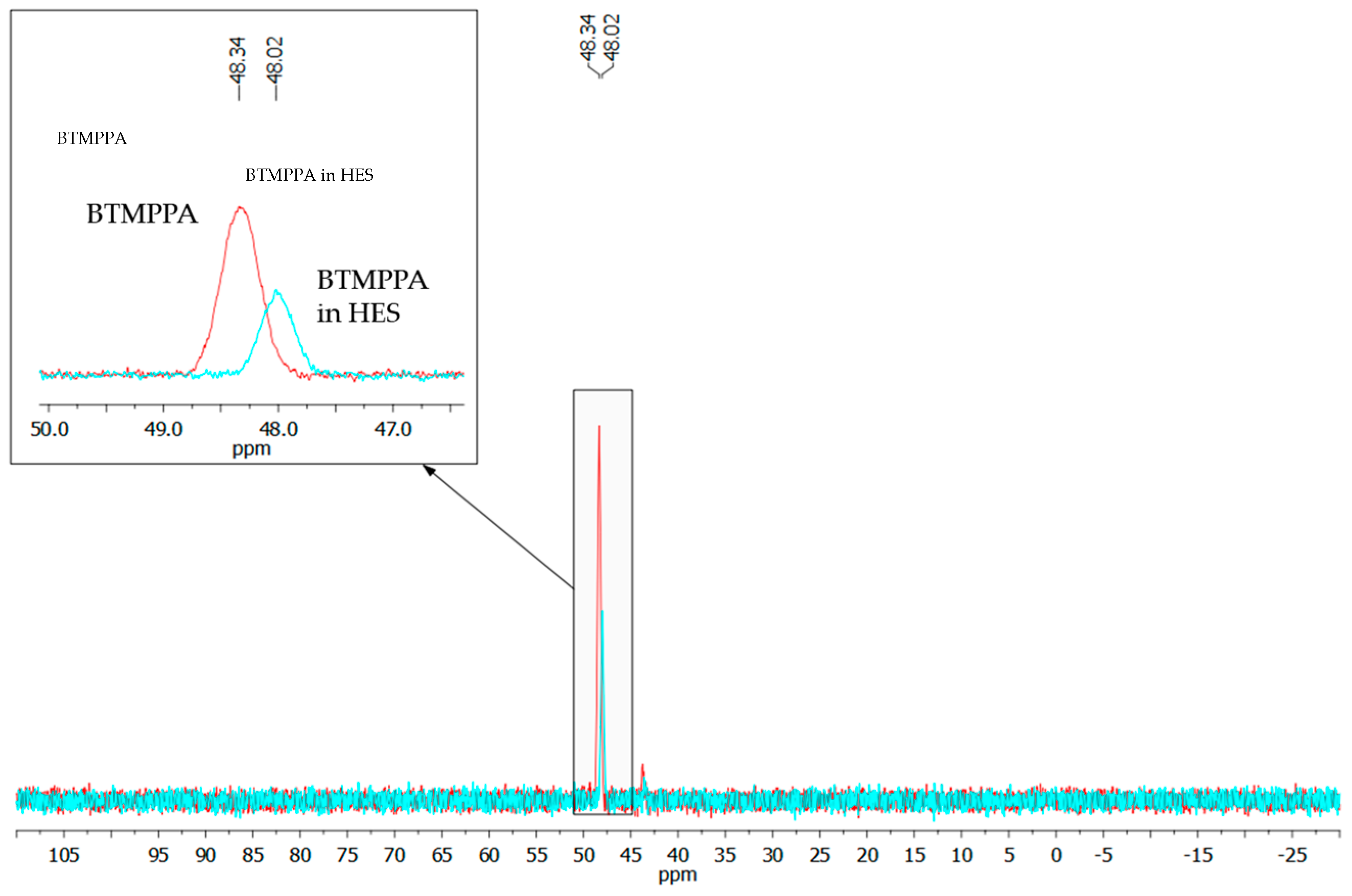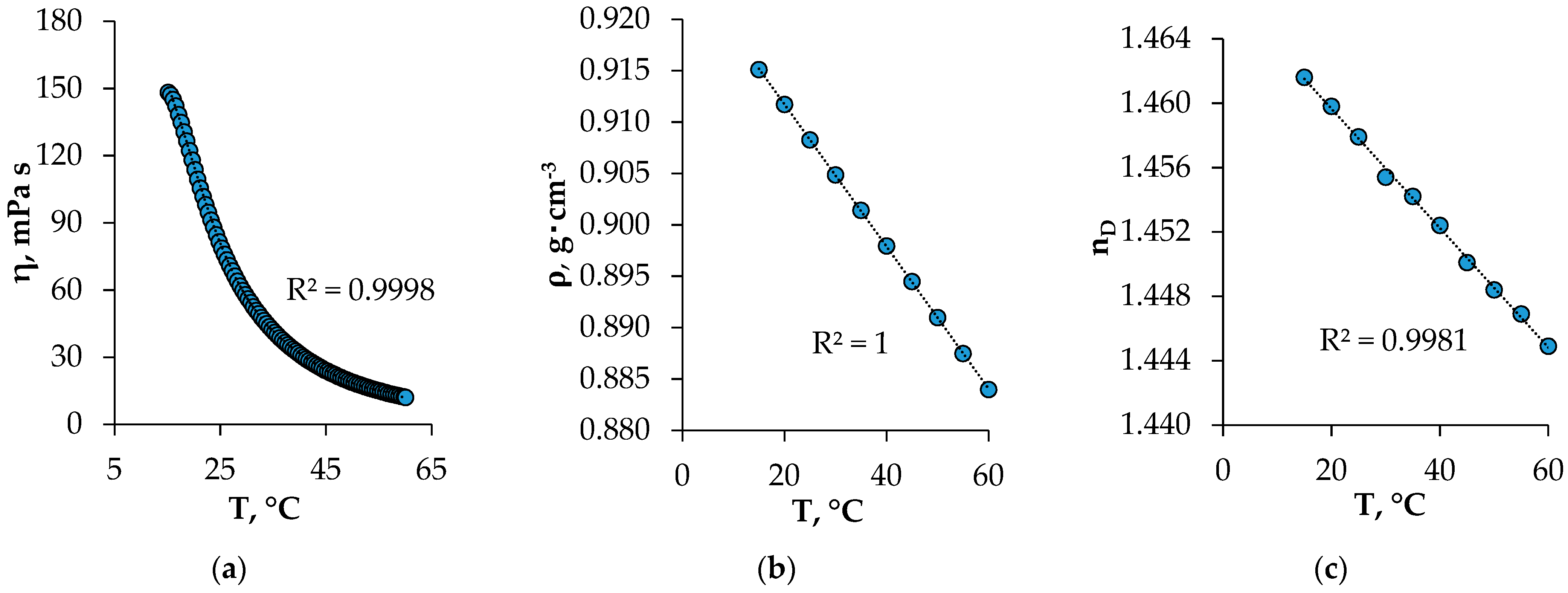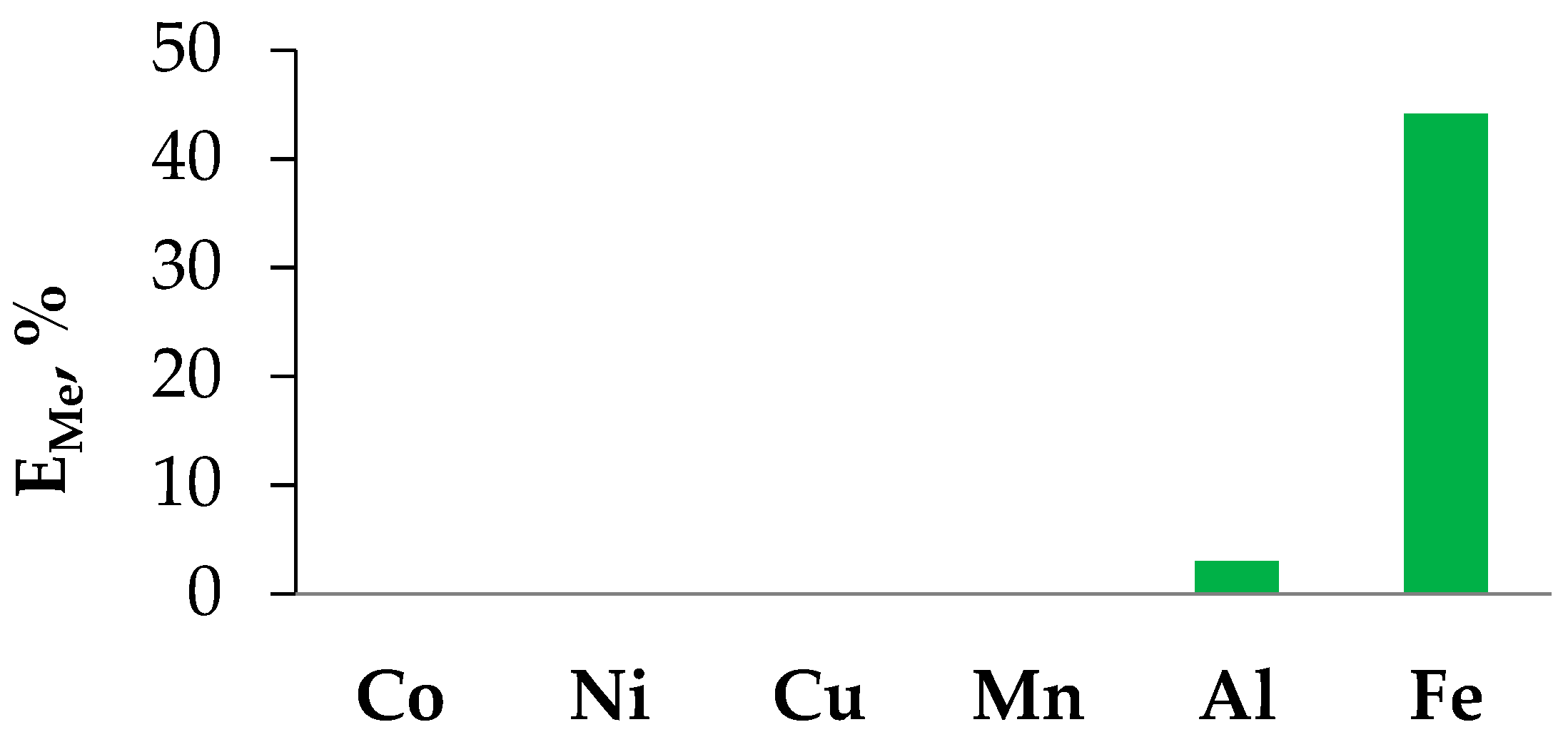New Hydrophobic Eutectic Solvent Based on Bis(2,4,4-trimethylpentyl)phosphinic Acid and Menthol: Properties and Application †
Abstract
:1. Introduction
2. Materials and Methods
2.1. Preparing of HES
2.2. Characterization of HES
2.3. Extraction of Metals with HES
3. Results and Discussion
Author Contributions
Funding
Institutional Review Board Statement
Informed Consent Statement
Data Availability Statement
Conflicts of Interest
References
- Eckert, C.A.; Knutson, B.L.; Debenedetti, P.G. Supercritical Fluids as Solvents for Chemical and Materials Processing. Nature 1996, 383, 313–318. [Google Scholar] [CrossRef]
- Zinov’eva, I.V.; Zakhodyaeva, Y.A.; Voshkin, A.A. Extraction of Monocarboxylic Acids from Diluted Solutions with Polyethylene Glycol. Theor. Found. Chem. Eng. 2019, 53, 871–874. [Google Scholar] [CrossRef]
- Freire, M.G.; Cláudio, A.F.M.; Araújo, J.M.M.; Coutinho, J.A.P.; Marrucho, I.M.; Lopes, J.N.C.; Rebelo, L.P.N. Aqueous Biphasic Systems: A Boost Brought about by Using Ionic Liquids. Chem. Soc. Rev. 2012, 41, 4966. [Google Scholar] [CrossRef] [PubMed]
- Asrami, M.R.; Tran, N.N.; Nigam, K.D.P.; Hessel, V. Solvent Extraction of Metals: Role of Ionic Liquids and Microfluidics. Sep. Purif. Technol. 2021, 262, 118289. [Google Scholar] [CrossRef]
- Smith, E.L.; Abbott, A.P.; Ryder, K.S. Deep Eutectic Solvents (DESs) and Their Applications. Chem. Rev. 2014, 114, 11060–11082. [Google Scholar] [CrossRef] [PubMed]
- Yu, D.; Xue, Z.; Mu, T. Eutectics: Formation, Properties, and Applications. Chem. Soc. Rev. 2021, 50, 8596–8638. [Google Scholar] [CrossRef] [PubMed]
- Abbott, A.P.; Boothby, D.; Capper, G.; Davies, D.L.; Rasheed, R.K. Deep Eutectic Solvents Formed between Choline Chloride and Carboxylic Acids: Versatile Alternatives to Ionic Liquids. J. Am. Chem. Soc. 2004, 126, 9142–9147. [Google Scholar] [CrossRef] [PubMed]
- Wang, R.; Fang, C.; Yang, L.; Li, K.; Zhu, K.; Liu, G.; Chen, J. The Novel Ionic Liquid and Its Related Self-Assembly in the Areas of Energy Storage and Conversion. Small Sci. 2022, 2, 2200048. [Google Scholar] [CrossRef]
- Kozhevnikova, A.V.; Zinov’eva, I.V.; Zakhodyaeva, Y.A.; Baranovskaya, V.B.; Voshkin, A.A. Application of Hydrophobic Deep Eutectic Solvents in Extraction of Metals from Real Solutions Obtained by Leaching Cathodes from End-of-Life Li-Ion Batteries. Processes 2022, 10, 2671. [Google Scholar] [CrossRef]
- Dwamena, A. Recent Advances in Hydrophobic Deep Eutectic Solvents for Extraction. Separations 2019, 6, 9. [Google Scholar] [CrossRef]
- Aşçı, Y.S.; Lalikoglu, M. Development of New Hydrophobic Deep Eutectic Solvents Based on Trioctylphosphine Oxide for Reactive Extraction of Carboxylic Acids. Ind. Eng. Chem. Res. 2021, 60, 1356–1365. [Google Scholar] [CrossRef]
- Mai, Y.; Xian, X.; Hu, L.; Zhang, X.; Zheng, X.; Tao, S.; Lin, X. Liquid–Liquid Extraction of Levulinic Acid from Aqueous Solutions Using Hydrophobic Tri-n-Octylamine/Alcohol-Based Deep Eutectic Solvent. Chin. J. Chem. Eng. 2023, 54, 248–256. [Google Scholar] [CrossRef]
- Wazeer, I.; Hizaddin, H.F.; Hashim, M.A.; Hadj-Kali, M.K. An Overview about the Extraction of Heavy Metals and Other Critical Pollutants from Contaminated Water via Hydrophobic Deep Eutectic Solvents. J. Environ. Chem. Eng. 2022, 10, 108574. [Google Scholar] [CrossRef]
- Gilmore, M.; McCourt, É.N.; Connolly, F.; Nockemann, P.; Swadźba-Kwaśny, M.; Holbrey, J.D. Hydrophobic Deep Eutectic Solvents Incorporating Trioctylphosphine Oxide: Advanced Liquid Extractants. ACS Sustain. Chem. Eng. 2018, 6, 17323–17332. [Google Scholar] [CrossRef]
- Alhadid, A.; Mokrushina, L.; Minceva, M. Formation of Glassy Phases and Polymorphism in Deep Eutectic Solvents. J. Mol. Liq. 2020, 314, 113667. [Google Scholar] [CrossRef]
- Regel-Rosocka, M.; Staszak, K.; Wieszczycka, K.; Masalska, A. Removal of Cobalt(II) and Zinc(II) from Sulphate Solutions by Means of Extraction with Sodium Bis(2,4,4-Trimethylpentyl)Phosphinate (Na-Cyanex 272). Clean Technol. Environ. Policy 2016, 18, 1961–1970. [Google Scholar] [CrossRef]
- Biswas, R.K.; Singha, H.P. Densities, Viscosities and Excess Properties of Bis-2,4,4-Trimethylpentylphosphinic Acid (Cyanex 272)+diluent Binary Mixtures at 298.15 K and Atmospheric Pressure. J. Mol. Liq. 2007, 135, 179–187. [Google Scholar] [CrossRef]
- Nowosielski, B.; Jamrógiewicz, M.; Łuczak, J.; Tercjak, A.; Warmińska, D. Effect of Temperature and Composition on Physical Properties of Deep Eutectic Solvents Based on 2-(Methylamino)Ethanol—Measurement and Prediction. J. Mol. Liq. 2023, 371, 121069. [Google Scholar] [CrossRef]
- Milevskii, N.A.; Zinov’eva, I.V.; Zakhodyaeva, Y.A.; Voshkin, A.A. Separation of Li(I), Co(II), Ni(II), Mn(II), and Fe(III) from Hydrochloric Acid Solution Using a Menthol-Based Hydrophobic Deep Eutectic Solvent. Hydrometallurgy 2022, 207, 105777. [Google Scholar] [CrossRef]
- Miao, Y.; Liu, L.; Zhang, Y.; Tan, Q.; Li, J. An Overview of Global Power Lithium-Ion Batteries and Associated Critical Metal Recycling. J. Hazard. Mater. 2022, 425, 127900. [Google Scholar] [CrossRef] [PubMed]





Disclaimer/Publisher’s Note: The statements, opinions and data contained in all publications are solely those of the individual author(s) and contributor(s) and not of MDPI and/or the editor(s). MDPI and/or the editor(s) disclaim responsibility for any injury to people or property resulting from any ideas, methods, instructions or products referred to in the content. |
© 2023 by the authors. Licensee MDPI, Basel, Switzerland. This article is an open access article distributed under the terms and conditions of the Creative Commons Attribution (CC BY) license (https://creativecommons.org/licenses/by/4.0/).
Share and Cite
Zinov’eva, I.V.; Kozhevnikova, A.V.; Milevskii, N.A.; Zakhodyaeva, Y.A.; Voshkin, A.A. New Hydrophobic Eutectic Solvent Based on Bis(2,4,4-trimethylpentyl)phosphinic Acid and Menthol: Properties and Application. Eng. Proc. 2023, 37, 68. https://doi.org/10.3390/ECP2023-14692
Zinov’eva IV, Kozhevnikova AV, Milevskii NA, Zakhodyaeva YA, Voshkin AA. New Hydrophobic Eutectic Solvent Based on Bis(2,4,4-trimethylpentyl)phosphinic Acid and Menthol: Properties and Application. Engineering Proceedings. 2023; 37(1):68. https://doi.org/10.3390/ECP2023-14692
Chicago/Turabian StyleZinov’eva, Inna V., Arina V. Kozhevnikova, Nikita A. Milevskii, Yulia A. Zakhodyaeva, and Andrey A. Voshkin. 2023. "New Hydrophobic Eutectic Solvent Based on Bis(2,4,4-trimethylpentyl)phosphinic Acid and Menthol: Properties and Application" Engineering Proceedings 37, no. 1: 68. https://doi.org/10.3390/ECP2023-14692
APA StyleZinov’eva, I. V., Kozhevnikova, A. V., Milevskii, N. A., Zakhodyaeva, Y. A., & Voshkin, A. A. (2023). New Hydrophobic Eutectic Solvent Based on Bis(2,4,4-trimethylpentyl)phosphinic Acid and Menthol: Properties and Application. Engineering Proceedings, 37(1), 68. https://doi.org/10.3390/ECP2023-14692







